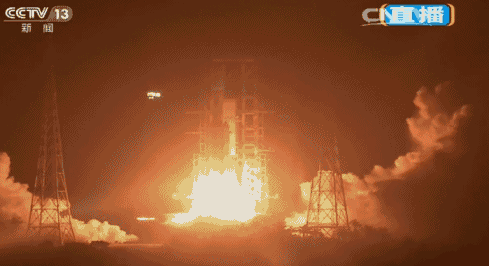
4月20日19时41分,搭载着天舟一号货运飞船的长征七号遥二运载火箭,在我国文昌航天发射场点火发射,约596秒后,飞船与火箭成功分离,进入预定轨道,发射取得圆满成功。

China has taken another step toward its goal of putting a space station into orbit around 2022, by sending its first cargo spacecraft Tianzhou-1 into space on Thursday evening.
我国首个货运飞船天舟一号于20日晚发射升空,我们朝着2022年前后建立轨道空间站的目标又迈进了一步。
Atop a Long March-7 Y2 carrier rocket, Tianzhou-1 rose into the air from the Wenchang Space Launch Center in south China's Hainan Province at 7:41 pm.
4月20日19时41分,搭载着天舟一号货运飞船的长征七号遥二运载火箭,在我国文昌航天发射场点火发射。
天舟一号(Tianzhou-1)是我国自主研制的
首艘货运飞船(the first cargo spacecraft developed by China)
,也是中国目前为止体积最大、重量最重的航天器(the largest and heaviest spacecraft)。
由于它只运货,不送人,所以被形象地称为
太空“快递小哥”(space courier/delivery man)
。

天舟一号采用两舱式结构,直径较小的是
推进舱(propelling module)
,直径较大的为
货物舱(cargo module)
。
飞船全长10.6米,最大直径3.35米,起飞质量(takeoff weight)约13吨,太阳帆板展开后最大宽度14.9米,物资运输能力(payload capacity)约6.5吨,推进剂补加能力约为2吨。
Tianzhou-1's 6.5-ton payload capacity also makes it the world's most capable cargo spacecraft in service: Japan's H-II Transfer Vehicle has 6 tons of payload capacity; the Cygnus and Dragon, both US-made craft, have 3.5 tons and 3.3 tons respectively; and Russia's Progress-MS has 2.2 tons.
天舟一号6.5吨的物资运输能力使其成为世界上运输能力最强的现役货运飞船:日本的H-II货运飞船运输能力为6吨;美国的“天鹅座”和“龙”飞船的运输能力分别为3.5吨和3.3吨;俄罗斯的进步-MS飞船为2.2吨。

飞船入轨后,将按预定程序与在轨运行的天宫二号先后进行自动交会对接(autonomous docking)、自主快速交会对接(autonomous fast docking)等3次交会对接,3次推进剂在轨补加(propellant in-orbit refueling)以及空间应用和航天技术等领域的多项实(试)验。

►►
首次对接
两天后,天舟一号与天宫二号进行首次交会对接。
之后,天舟一号与天宫二号组合体将进行为期两个月的在轨飞行。
期间,计划完成3次推进剂在轨补加试验(experiments on propellant in-orbit refueling),同时测试货运飞船对组合体的控制能力(test the controlling ability of the cargo spacecraft over the two spacecraft)。
►►
二次对接
完成首次对接后,天舟一号与天宫二号分离,然后绕飞到天宫二号的另一侧,进行第二次对接。
第二次对接的主要任务是进行绕飞实验(fly-around tests),检验天舟一号前向对接能力(capability of forward docking)。
之后天舟一号与天宫二号再次分离,两个飞行器将独立飞行三个月,完成搭载的空间科学试验(space scientific experiments)。
►►
三次对接
天舟一号与天宫二号进行最后一次对接,验证自主快速交会对接(autonomous fast docking)技术,要求在六小时左右实现对接。
完成所有既定任务后,天舟一号将受控离轨,陨落至空间安全海域(fall into a designated sea area)。
此次任务是中国载人航天工程空间实验室阶段(space laboratory stage of China manned space engineering)的收官之战,对于空间站工程后续任务顺利实施具有极为重要的意义,将标志着中国载人航天工程胜利完成“三步走”战略中的“第二步”任务,为空间站建设任务奠定坚实技术基础。
1992年9月,中国实施载人航天工程并确定中国载人航天“三步走”的发展战略(three-step manned space program):
第一步,发射载人飞船(manned spaceship),建成初步配套的试验性载人飞船工程,开展空间应用实验。2013年神舟5号载人飞船任务顺利完成。
第二步,突破航天员出舱活动技术(extra-vehicular activity)、空间飞行器的交会对接技术(rendezvous and docking),发射空间实验室(space lab),解决有一定规模的、短期有人照料的空间应用问题。
第三步,建造空间站,解决有较大规模的、长期有人照料的空间应用问题(operate a permanent manned space station)。
编辑:马文英






